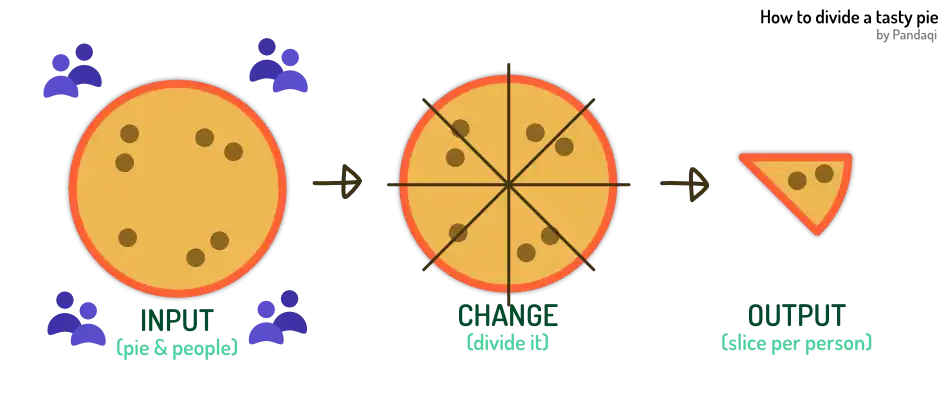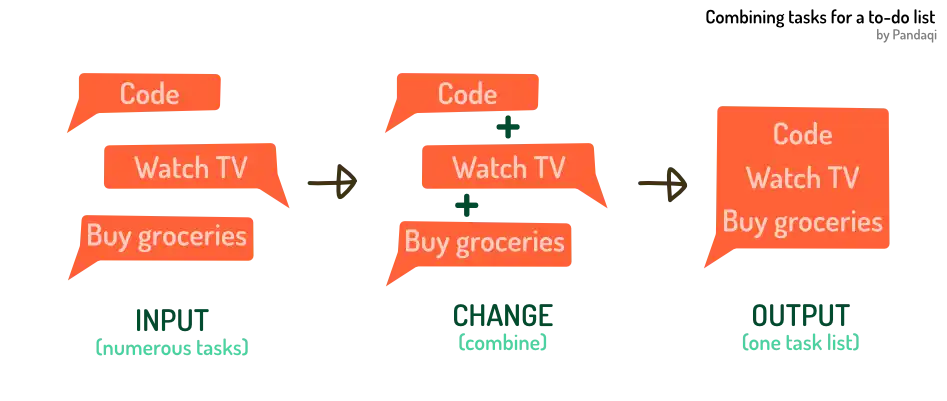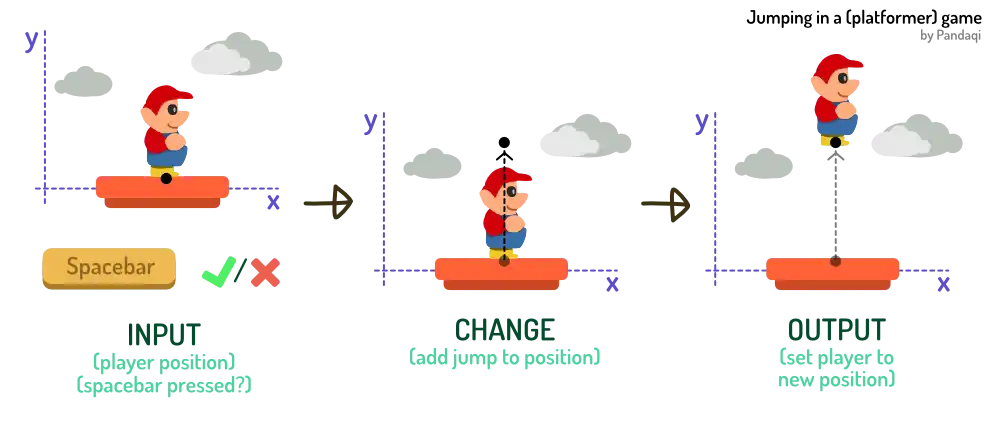Solving Puzzles
You have something you want to do. A problem to solve—or a puzzle, that sounds more fun.
Say you’re making a game. You want the character to jump when the player presses spacebar. It won’t happen magically. Hey, that’s a puzzle we need to solve!
How do you get that character to jump? How do you know when the player presses spacebar? How do you tell the computer how to solve this problem?
And that’s where programming (or coding) comes in.
It provides a language, a grammar, for communicating your idea with the computer. For telling it what “jumping” means, or what “spacebar” means. The computer doesn’t know! It’s just a calculator! It only knows numbers and arithmetic.
I once heard a fun quote about this. “Which one is smarter, a shoe or your smartphone?” The answer … it’s a tie. They’re both equally dumb.
The coding loop
This means programming always has the following steps. You …
- Find your problem
- Ask input: the information you need. (What’s the status of that spacebar key?)
- Turn it into numbers
- Get output: convert the numbers into what you wanted to do. (How much should the player move upwards?)
- Apply that to solve your problem!
The formal term for this is “data transformation”. It just means you get some numbers as input, change them, then do something with that output. Because numbers are “data”. And “transform” is just another word for change.
As you read this course, you’ll see that coding is just this loop over and over. And I’ll give more tips about how to code well, now that you know about data transformations.
In fact, I’ll remind you about this every time. Whenever I introduce a new idea or syntax, I’ll add a little icon () and state the data transformation happening. On wide screens, these appear to the side (with the other side notes). On small screens, they appear within the text.
Example 1
Let’s see our first example. We have a delicious pie and want to divide it among everyone at the party. Obviously, we want everyone to get an equal slice of pie!
What do we do?
- We collect our input: the pie and how many people there are
- We transform it: divide the pie by that amount of people
- We output it: print what percentage everyone gets (on our screen)

Try it! Change the number of people to another number.
Yes, you’ve learned your first keyword: say. Whatever comes after it is printed on the page! Use this to get feedback on what the code is doing, throughout this course.
Results from examples always show below the code block. All languages have this and usually call it logging. Because its main purpose is to log errors, warnings or output while you try to develop.
Press the “settings” icon (top right) to change what the examples print to your browser.
Example 2
Maybe I’m designing an app for keeping a “to-do list”. I want to display the whole list to the user at the home screen.
What do we do?
- We collect our input: all the tasks on the list
- We transform it: we add them together
- We output it: we print this list to the user

All programming languages can handle text like above. Pretty much all of them place text between quotes (")—but more on that soon.
Try it! See if you can add more tasks to the list.
Example 3
Let’s finish this chapter with a more challenging example. Let’s try to write code for our “player jumping” example. (Like in a platformer game, such as Mario.)
Try to figure out the general idea—before reading the code. Think about the data transformation: what information do you put in? And how do you need to change it?
Sometimes it helps to make it more specific: what exactly do we want as output? Can we turn that into a number?
Jumping means going up, vertically, right? This means the computer needs some concept of horizontal and vertical. Fortunately, any software will have that by default. They are called the x-axis (horizontal) and the y-axis (vertical).
But that’s not enough. What is up? The computer doesn’t know—it knows nothing. We need to tell it what we think is “up”. In our case, let’s say that higher numbers means up. (So Y = 5 is more up than Y = 4.)
Now we’ve turned our problem into numbers!
To make the player go up when spacebar is pressed, we also need this data:
- Where the player is now. We can’t go “higher than we are” if we don’t know where we are now!
- Whether spacebar is pressed: either yes or no. In coding, this is often called
trueorfalse
Any “game engine” will have a simple function to check whether a key is pressed. (Or the mouse used, or a joystick moved, etcetera.)
Our wanted output is this new position of the player. What is this? It’s their old position plus the change.

Bringing it together, the code might look like this.
Voila!
A real example
I want this course to be practical. So let me tell you what I’m working on right now. An actual, real-life, application of the ideas above.
Getting a random word
I publish games under the Pandaqi name. Lately, I had many ideas for word games.
Which gave me a problem: how do I get a random list of English words a player could draw / use?
Let’s identify our data transformation.
- Input: a big wall of text
- Change: convert the text into individual words
- Output: tell the player this selected word
Where do we get our input? You probably just said: a dictionary. But … a paper dictionary obviously wouldn’t do. Nor would an online website. Computers don’t understand clicking, buttons and interfaces.
Computers calculate and see patterns, that’s all. So they’ll only understand the words if I give them in a predictable pattern.
I ended up creating a new text (.txt) file for each category of words. Within, I wrote every word on its own line. Then I can use code to detect when a new line starts: what follows will be a single word.
Tada! Now my code transforms the data correctly. It takes a file (input), cuts them into individual words (change), then gives me one random word from that list (output)
I’ve spent the past few weeks building this dictionary. Others have had the same idea … but I couldn’t use theirs. My games have more specific requirements, such as words being easy enough that even a child would understand.
As you code more, you’ll see this is often the case. Copy-pasting somebody else’s code can be the solution. But your problem to solve is often (slightly) different, which means coding your own solution is better in the long run.
Generating images
Similarly, I’ve created board games where you can randomly generate a board! (Such as Timely Transports or my first word game Keebble.)
The data transformation is clear.
- Input: the settings a player wants to use. (Number of players, paper size, difficulty, etcetera.)
- Change: convert these to visual marks on the page. (For example, place a “starting square” for each player.)
- Output: the final graphics as an image to download / print
Look at any digital project with this perspective. You’ll start to notice the data transformations making it all happen. Once you have an intuition for that, you’re already 90% a professional programmer.
Conclusion
Next chapter will dive into actual code writing. Let’s continue this adventure!
Want to support me?
Buy one of my projects. You get something nice, I get something nice.
Donate through a popular platform using the link below.
Simply giving feedback or spreading the word is also worth a lot.